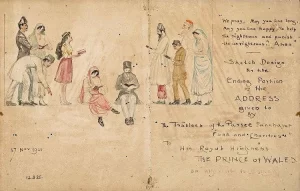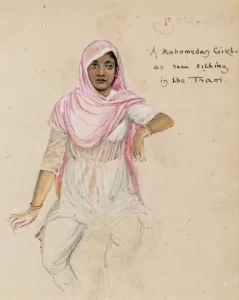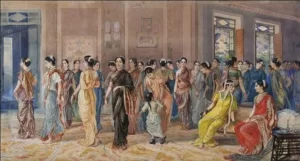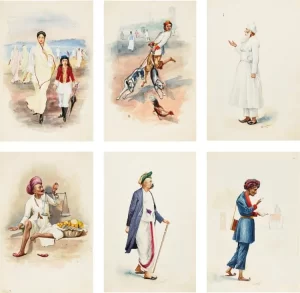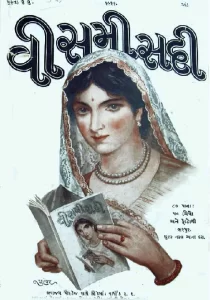Digvijay Nikam
In the late 19th and early 20th century when the Nationalist movement in India was in full sway with the revivalist school of painting in Bengal responding to its current techniques and content that departed from the British academic style, the Bombay artists were producing work that was highly academic in nature. Mahadev Vishwanath Dhurandhar was one of the most successful painters among the Bombay artists who contributed significantly to the pre-independence Indian art scene.
Born in 1867 in a Marathi Pathare Prabhu family at Kolhapur, Maharashtra, Dhurandhar’s father gauged his extraordinary artistic talents and put him under the tutorship of the famous painter Abalal Rahman. He went on to graduate with an excellent academic record from the Sir J.J. School of Art in the 1890s where he was a student of the artist John Griffiths. Later, he was offered a position at the same school and throughout his career he held various positions in the institution eventually becoming the Vice-Principal for two years before retiring.
It was at the Sir J.J. School of Art with its curriculum based on the Royal Academy of Art that artists like Dhurandhar were trained in the realist style of painting when many artists across the country and globe were engaging in experimentation with technique and subject matter. It is this academic realist style that gives his work a documentary dimension allowing art historians like Partha Mitter to categorise him as a dissident figure in the late nineteenth and early twentieth century when the figure of the artist as a romantic outsider creating timeless pieces was an established convention in the modernist imagination.
Untitled. 1925. M. V. Dhurandhar. Courtesy of invaluable.com.
With a staggering oeuvre of 5000 paintings and over 50,000 illustrations, Dhurandhar’s practice covered portraits, landscapes, episodes from history and mythology, as well as documentation of social life, rendered by way of oil paintings, watercolours, drawings, and sketches. His most popular paintings include his illustrations of women in daily life. These illustrations capture women in a multiplicity of postures, the spectrum of which is quite novel and intriguing. There are women preening, travelling in a tram, draping the polka, showing the Padar, returning a serve, offering Naivedya (food offering for God) or interestingly a woman cleaning herself after urination.
A Mohammedan girl is seen sitting in the tram. 1919. Courtesy of Bonhams.
As pointed out earlier, one of his important subjects included documenting the lives of people around him and their way of living, especially his own Pathare Prabhu community, through paying attention to their peculiar occupations, rituals, and festivals. One of his most remarkable paintings is that of a Hindu marriage ceremony that shows his attention to detail in depicting women in the fashionable 9-yard saree, high-heeled shoes, and hair buns embellished with Gajras.
Scene of Hindu Marriage Ceremony. Courtesy of tallengestore.
Hundreds of his paintings feature figures like potters, dancers, worshippers, fisherwomen, pram-pushing ayahs, dog-walkers, and shoe shiners. Apart from their documentary impulse these paintings as well as his oeuvre in general exhibit a theatricality that lends them a distinctive liveliness. This theatrical realism can be traced back to the flourishing Marathi and Parsi theatre industry as well as studio photography in early 20th century Bombay.
Twenty Watercolours Depicting Scenes of Bombay. Courtesy of invaluable.com.
Simultaneously, Dhurandhar was also active in the commercial art domain creating posters, postcards, book covers as well as oleographs. He also provided illustrations for S. M. Edwardes’ By-Ways of Bombay (1912), Otto Rothfield’s Women of India (1920), and C.A. Kincaid’s Deccan Nursery Tales while drawing cartoons and covers for the Gujarati periodicals Aram, Bhoot and Vishmi Sadi (The Twentieth Century). It is for this reason that scholars consider him a pioneer in applied arts and an apt successor of someone like Raja Ravi Verma given his ability to tap into different clientele bases.
Cover of 1916 issue of Visami Sadi. Courtesy of Wikipedia.
Dhurandhar has historically been understood as the ideal colonial mimic who was subservient to the imperial masters in every sense and who did not engage with the freedom movement at all through his artistic practice. However, this straight-jacketed narrative does not allow us to grasp the complexity of a figure operating at a crucial juncture in Indian history. Scholars like Professor Shukla Sawant are reexamining his career to offer newer perspectives. She argues that Dhurandhar subtly challenged the colonial structures through the painting circuits he developed, the patronage structures he was able to build as well as the writing he produced. In his very mimicking he expressed a competitiveness to draw better than his colonial masters, to show them that he was more adept and at ease in their techniques than they themselves were.
Dhurandhar was one of the earliest Indian artists to create a substantial body of writing primarily in Marathi but in English as well. He wrote about the work of his contemporaries in a magazine called Vasundhara in a series of articles titled ‘Maze Samakalin Chitrakar’ (My Contemporary Artists) featuring artists such as Manchershaw F. Pithawalla, Sawlaram L. Haldankar and Dwarkanath Mahatre. He also wrote an autobiography titled Kalamandiratil Ekkechalis Varshe which documents his eventful career from being a young student artist to becoming the director of Sir J.J. School of Art.
In Dhurandhar we find a painter and an academic who had a hugely successful career but one who has not yet been received with adequate attention in scholarly circles. A chronicler of everyday reality and a pioneer of commercial art, it is high time that we start revisiting some of these forgotten stalwarts of Indian art history.
References
- https://asiasociety.org/india/events/mv-dhurandhar-unexplored-history
- https://www.tallengestore.com/collections/m-v-dhurandhar
- https://en.wikipedia.org/wiki/M._V._Dhurandhar
- https://www.saffronart.com/artists/mahadev-visvanath-dhurandhar
- https://www.youtube.com/watch?v=99G_c_P_Grc
https://www.youtube.com/watch?v=U2rODPzSqJ4




